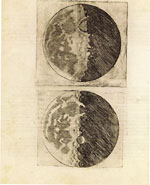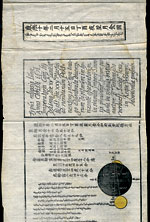America at Auction
The Starry Messenger
Sidereus nuncius by Galileo Galilei, $662,500 at Christie’s New York on December 2.
A foundation work in astronomy, this is the first account of discoveries made with a telescope and includes among its many illustrations and diagrams, five half-page etchings of the lunar surface and phases. With his improved telescope, Galileo found that the moon was mountainous and the Milky Way was a mass of separate stars. He also identified four satellites of Jupiter, which he diplomatically named Medicean Stars in honor of Cosimo II de’ Medici.
Nowhere in the book did Galileo explicitly support the heretical heliocentric views of Copernicus, but as well as bringing him fame, the book prompted virulent attacks from supporters of the accepted order. These mostly focused on the reliability of the telescope rather than on the implications of his observations, but Galileo had been careful to legitimize his discoveries by linking them to the Medicis, and by using the family’s contacts to distribute telescopes and copies of this epochal work to other European princes and the cultural elite.
This copy of the ‘Starry Messenger’ was that which in 1998 had sold in the same rooms for $387,500 as part of the magnificent Haskell F. Norman scientific library. It is bound in contemporary limp vellum with a 1611 work by Marko Dominis, a Croatian physicist and Archbishop of Split, that offers a theoretical explanation of the telescope (one that mistakenly led to the long-held belief that Galileo, not Hans Lipperhey, had invented the telescope) and the best early attempt to describe how a rainbow is formed.
This and the fact that Dominis, too, fell foul of the Inquisition—though in his case, for the heresy of advocating Christian unity not his scientific views—make it a very appealing copy. Setting a new record for the work in selling to an American collector, it was offered as part of a sale called ‘Beautiful Evidence,’ a diverse and somewhat quirky collection formed over thirty years by Edward Tufte, Professor Emeritus of Statistics, Political and Computer Science at Yale University and a writer whose special interest is information design.
Chinese Tradition Eclipsed by Western Science
Typus Eclipsis Lunae by Fr. Ferdinand Verbiest, Euros 49,200 ($67,645) at Romantic Agony Auctions in Brussels on November 19.
Xylographically printed (i.e., woodblock-printed) in Beijing in 1671 on two sheets of silk paper and originally folded into sections, this work by a famous Flemish-born Jesuit missionary, mathematician, and astronomer, is an illustrated prognostication of a lunar eclipse of March of that year. It was also one of the ways Verbiest attempted to demonstrate the superiority of European science over traditional Chinese beliefs when it came to studying the heavens.
Sometime after 1684, a small number of copies was brought back for distribution in Europe by another Jesuit missionary, Philippe Couplet. But only one other copy of this scarce item appears in auction records – the one in the vast library formed in the nineteenth century by that most voracious of collectors, Sir Thomas Phillipps. In 1945, in what was then the greatest single purchase in the history of bookselling, London dealers Lionel and Philip Robinson bought the impressive remnants of the Phillipps library, and spent many years thereafter selling it off at Sotheby’s in London.
The Phillipps copy of Typus Eclipsis Lunae went into Philip Robinson’s own Chinese library, and in his 1988 sale made £13,750 (then $26,265) at Sotheby’s. His collection also included Verbiest’s Typus Solis, a similarly constructed prediction of a solar eclipse of 1669, which sold at £12,650 ($24,160).









